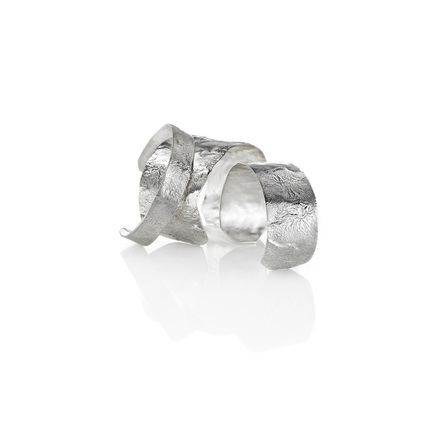14" = 35.5 cm
16" = 40.6 cm
18" = 45.7 cm
20" = 50.8 cm
24" = 61 cm
30" = 76 cm
33" = 84 cm
|
Wondering exactly where an 18" chain is going to fall? Look no further! And for those of you who live outside the U.S. where measurements actually make sense, I've listed the metric conversions for you below. Approximate metric conversions for necklace lengths:
14" = 35.5 cm 16" = 40.6 cm 18" = 45.7 cm 20" = 50.8 cm 24" = 61 cm 30" = 76 cm 33" = 84 cm
1 Comment
 After you purchase your cuff bracelet, you will want to adjust it to fit your wrist so that it does not have to be done again every time you wear it. Over time, metal that has been repeatedly stretched and compressed will stress, and may form a crack or weakened area that can limit the life of the bracelet. Luna cuffs can be gently adjusted about one half inch either way. Properly fitting your cuff will ensure that it lasts a lifetime. If needed, carefully open your bracelet, by very gently but firmly pulling the two ends apart, so that it fits over your wrist from the side. Place the open part of the bracelet at the side of the narrowest part of your wrist, moving far enough to be able to turn it into the correct position. When the bracelet is placed as you want to wear it, gently squeeze it just enough to fit comfortably, and so that it can still be removed by reversing the process. The next time you put it on, it will fit perfectly without adjustment. Check out this cool online interactive ring sizing website I just found. It takes all the guesswork out of sizing your rings. Just click on the photo below. If you are planning on ordering a wide band (anything over 1/2"), or stacking multiple thin bands, be sure to order a half size UP from your normal size. This will accommodate for the extra width on your finger and ensure that the bands aren't too tight.
There are a lot of different metals out there, and sometimes it can be confusing when trying to tell the difference. Vermeil (pronounced vur-may) is a heavy gold plate over sterling silver. A typical example is sterling silver plated with 14 carat (58%) gold. In order for an item to be considered vermeil, the gold must be at least 10 carat (42%) and be a minimum of 2.5 microns thick. In the US, sterling silver covered with a base metal, or any other plain base metal, plated with gold cannot be sold as vermeil.
Vermeil is produced by coating sterling silver with carat gold using the process of electrolysis -- an electricity in an acid bath -- to attach the gold to sterling. This 2.5 micron (100 millionths of an inch) thick layer of gold is significantly heavier than the gold applied to base metal using an electroplating process (only 0.175 microns or 7 millionths of an inch), and is therefore much more durable. Any of Night Fox's silver pieces can be done in vermeil. So if you are wondering whether a vermeil piece is worth the investment, be assured that you will have a lovely, high quality piece that can last for generations. Sources: Wikipedia, Red Sky Plating, BondedInfo.com  Introducing Genevieve Smith, our stunning new model who was gracious enough to help us out with a last minute photo shoot for Boticca last week. Here are a few of the new shots. Be sure to check out Boticca in the coming weeks to see all the latest pieces. Photos by Kelsey Parfitt Photography Well, I finally decided to try and catch up with the times by joining Twitter. Follow me? Please?
https://twitter.com/nightfoxjewelry One of the frustrations of owning silver jewelry is that it tarnishes. For most people, frequent wearing keeps silver jewelry relatively clean. But what about those other pieces that just hang out in our jewelry boxes until we go to put them on, only to find that they are too dirty to bother with at the last minute? If you aren't a professional jeweler with access to buffing and ultra sonic machines, what should you do? Polishing clothes are a good, cheap way to clean jewelry, but take a lot of elbow grease. The drawback to a polishing cloth is that it's difficult to get into small grooves in metal. My favorite way to clean jewelry is Wright's Silver Cream. It is gentle, safe on most stones, and super easy. A small tub will likely last a lifetime and is worth the investment. Most importantly, the best way to keep already clean jewelry clean is to keep it in an airtight zip lock plastic bag. Exposure to air is what causes the oxidation to take place on otherwise lovely silver. So save yourself some time and effort by keeping your jewelry in bags.
If you are interested in purchasing a polishing cloth or cream, just click on the links below. I started this blog post and then my computer died. It's still mostly relevant, so I thought I'd finish it up and publish it now that my computer is functioning again. So, a while back... Maybe it's because it's nearing the end of March and there's a winter storm warning in effect that has me dreaming about warmer climes, but water has been on my mind a lot lately. Many people assume that the inspiration for my work comes from the snow, ice, and wide open spaces that surround me, but when I work it's usually water that I see. Check out some of my some of my favorite water pictures below. They are all photos I took myself and most of them I would like to see again. Which one is your favorite? "The cure for anything is salt water -- sweat, tears, or the sea." -Isak Dinesen |
Kate Finley
I started to work on this blog but that dog up there distracted me with his antics. Check back soon though--surely he can't keep this up all day. Archives
October 2015
Categories
All
|
